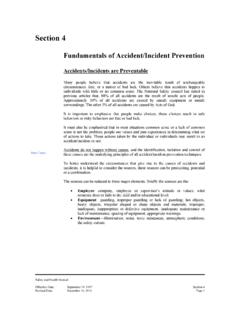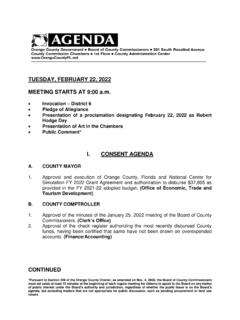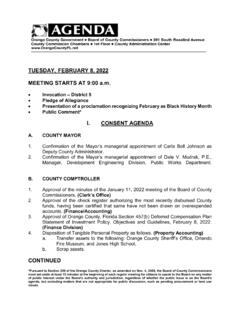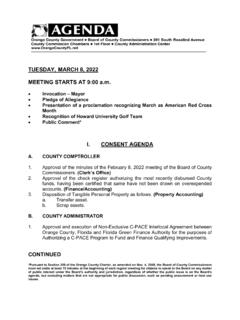Transcription of Root Cause Analysis - OCFL
1 Fixing the System with root Cause Analysis Copyright statement. This educational information is provided by the Public Education and Conferences Section of the Oregon Occupational Safety and Health Division (Oregon OSHA), Salem, Oregon, USA. Unless a copyright is indicated, information herein is in the public domain and may be copied and distributed without permission. Citation of Oregon OSHA as source of the information is appreciated. This document is originally published in Microsoft PowerPoint.
2 Permission to use PowerPoint graphics must be obtained from Microsoft Inc. If a copyright is otherwise indicated on a photo, graphic, or other material, permission to copy these materials must be obtained from the original source. Disclaimer. This information provides suggested methods for presenting various safety and health related topics. This material, or any other material used to inform employers of compliance requirements of Oregon OSHA standards through simplification of the regulations should not be considered a substitute for any provisions of the Oregon Safe Employment Act or for any standards issued by Oregon OSHA.
3 Get to the roots to fix the system The hazardous conditions and unsafe behaviors we identify as contributing to the accident are called the surface causes of the accident. After we identify surface causes , we'll need to determine if inadequate safety system components contributed to the accident by allowing the hazardous conditions and unsafe behaviors to develop or occur. These system inadequacies are called the root causes of accidents. Let's take a closer look at these two very important concepts.
4 The surface causes of accidents The surfaces causes of accidents are those hazardous conditions and unsafe employee/manager behaviors and activities that have directly caused or contributed in some way to the accident. Hazardous conditions: are basically things or objects that Cause injury or illness may also be thought to be defects in a process may exist at any level of the organization Hazardous conditions may exist in any of the following categories: Materials Machinery Equipment Environment Chemicals Tools Workstations Facilities People Workload Time It's important to know that most hazardous conditions in the workplace are the result of an unsafe behaviors that produced them.
5 Unsafe behaviors: are actions we take or don't take that increase risk of injury or illness. may also be thought to be errors in a process may occur at any level of the organization. Some example of unsafe employee/manager behaviors include: Failing to comply with rules Using unsafe methods Taking shortcuts Failing to report injuries Failing to report hazards Horseplay Allowing unsafe behaviors Failing to train Failing to supervise Scheduling too much work Ignoring worker stress Failing to correct The direct Cause of injury is not the Cause of the accident If we examine the surface Cause categories above, we find that each may somehow produce a harmful level of energy that may be transferred to our body directly causing an injury.
6 The harmful transfer of energy is the direct Cause of injury. Let's take a look at three examples: If a harsh acid splashes on our face, we may suffer a chemical burn because our skin has been exposed to a chemical form of energy that destroys tissue. In this instance, the direct Cause of the injury is harmful a chemical reaction. The related surface Cause might be the acid (condition) or working without proper face protection (unsafe behavior). If our workload is to too strenuous, force requirements on our body may Cause a muscle strain.
7 Here, the direct Cause of injury is a harmful level of kinetic energy (energy resulting from motion), causing injury muscle tissue. A related surface Cause of the accident might be fatigue (hazardous condition) or improper lifting techniques (unsafe behavior). The important point to remember here is that the "direct Cause of injury" is not the same as the surface Cause of the accident. To summarize: The surface Cause of the accident describes a condition or behavior. The result of the condition and/or behavior is the direct Cause of harmful transfer of energy.
8 The direct Cause of injury is the harmful transfer of energy. The direct result is injury. Safety Engineering & Safety Management two different roles Safety "engineers" closely analyze all the surface Cause categories and attempt to (1) eliminate the harmful energy, (2) reduce the harmful energy transfer, or (3) reduce exposure to harmful energy transfer. They do this by designing safety features directly into tools, machinery, equipment, facilities, etc. On the other hand, safety managers identify and analyze the safety management system to evaluate the effectiveness of its subsystem components.
9 They improve the system to eliminate or reduce the common or root causes producing the hazardous conditions and behaviors. Workplace safety is most successful when engineering controls and management system improvement compliment each other. The root causes of accidents The root causes for accidents are the underlying safety system weaknesses that have somehow contributed to the existence of hazardous conditions and unsafe behaviors that represent surfaces causes of accidents. It's important to understand that root causes always pre-exist surface causes .
10 Indeed, inadequately designed system components have the potential to feed and nurture hazardous conditions and unsafe behaviors. If root causes are left unchecked, surface causes will flourish! Examples of safety system functions and the components common to all systems include: Safety systems: Systems are developed to: Promote Commitment/leadership Increase employee involvement Establish accountability Identify and control hazards Investigate incidents/accidents Educate and train Evaluate the safety program System components.











